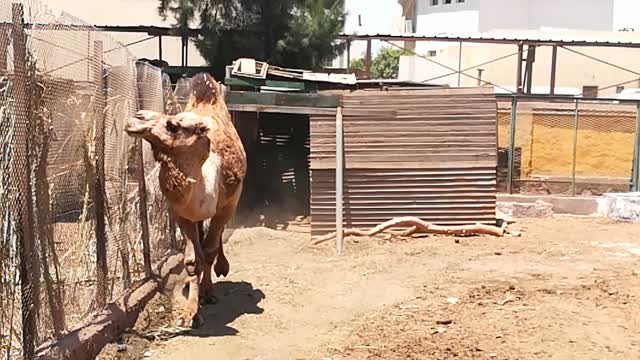Premium Only Content

Camel Turned Hot by visitors attention
Camel Turned Hot by visitors attention
Although we more typically associate camels with the deserts of the Middle East, there are millions of these large-eyed ungulates living in Africa. Most of them are found in North Africa, either in countries like Egypt and Morocco that border the Sahara Desert; or in Horn of Africa nations like Ethiopia and Djibouti.
There are three species of camel found worldwide, and the African species is more properly known as the dromedary or Arabian camel. While other camel species have two humps, the dromedary is easily identified by its single hump. Dromedaries have been domesticated for at least 4,000 years, and no longer occur naturally in the wild. Over the last four millennia, they have become indispensable to the people of North Africa.
Camels are used for transport, and for their meat, milk, wool, and leather. They are well-adapted to waterless environments and are therefore far better suited to life in the desert than conventional working animals like donkeys and horses. Their resilience made it possible for North African ancestors to establish trade routes across the Sahara Desert, linking West Africa to North Africa.
Fun Camel Facts
In Somalia, camels have held in such high esteem that the Somali language includes 46 different words for 'camel.' The English word 'camel' is thought to derive from the Arabic word Ǧamāl, which means handsome--and indeed, camels are quite dashing, with their long, slender necks, regal air, and impossibly long eyelashes. Their eyelashes are double-rowed and serve the practical purpose of keeping sand out of the camel's eyes.
Camels have several other unique adaptations that make it possible for them to survive in the desert. They are able to control their own body temperature, thereby reducing the amount of water that they lose through sweat. They can close their nostrils at will, which also reduces water loss while helping to keep sand out; and they have an exceptionally fast rate of rehydration. Camels can go as long as 15 days without water.
-
 1:01
1:01
lkro63
3 years agoVisitors
50 -
 1:11:43
1:11:43
Roseanne Barr
7 hours ago $3.64 earned"They are all Monsters" | The Roseanne Barr Podcast #89
33.5K27 -
 9:26:16
9:26:16
Dr Disrespect
11 hours ago🔴LIVE - DR DISRESPECT - WARZONE - PR ATTEMPTS
71.4K29 -
 LIVE
LIVE
Akademiks
2 hours agoDay 1/30. Lebron checks stephen a Smith. TOry Lanez talking CRAZY asf. Lil Ronnie K*Ilers Caught
3,335 watching -
 LIVE
LIVE
I_Came_With_Fire_Podcast
6 hours agoDEPARTMENT OF EDUCATION AXED | GAZA ULTIMATUM
366 watching -
 2:16:53
2:16:53
FreshandFit
3 hours agoCall-In Show
38.3K6 -
 4:27:46
4:27:46
Nerdrotic
7 hours ago $5.62 earnedDaredevil Born Again REVIEW, Harry Potter Show DOA, DC HACKED! | Friday Night Tights 344 Paul Chato
108K33 -
 1:15:15
1:15:15
Glenn Greenwald
4 hours agoWeek in Review: Lee Fang and Leighton Woodhouse on Ukraine War and NYT Piece Revealing Tensions within Trump Admin; PLUS: Lee Fang Takes Audience Questions on DOGE and Big Tech | SYSTEM UPDATE #420
53.9K36 -
 1:03:30
1:03:30
Sarah Westall
6 hours agoMassive Government Overhaul: FBI, CIA, IRS and more to be Gutted w/ Sam Anthony
64.9K13 -
 1:07:40
1:07:40
IsaacButterfield
6 hours ago $0.39 earnedAustralia Under Attack | Trump's State of the Union | All LGBTQ Cast (W Guest Frenchy)
27.7K4